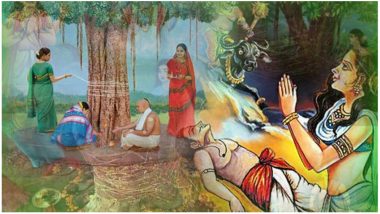Vat Savitri Amavasya Vrat also called as Vat Amavasya is an important traditional fast that is observed by married women in North India. The states of Uttar Pradesh, Madhya Pradesh, Bihar, Punjab and Haryana, follow the Purnimanta calendar and hence they celebrate Vat Savitri Vrat 15 days before. The other states usually follow the Amanta lunar calendar and hence the dates may differ. North India observes the vat puja on Jyeshta Amavasi day. This year Vat Savitri will be celebrated on May 15. Married women perform the Vat Amavasya puja for the prosperity, longevity and happiness of their husbands and for a good family life. They keep a fast for their husbands. Here are the details of time, puja vidhi, muharat and significance of the fasting observed on this auspicious day.
Vat Savitri Vrat Timings & Muharat
Amavasya Tithi will begin at 10:16 pm on May 15, 2018
Amavasya Tithi will end at 7:47 pm on May 15, 2018
Vat Savitri Puja Vidhi
According to Drikpanchang, devotees should start the puja vidhi with the meditation of Lord Brahma along with his consort Savitri. Panchamitra bath – mixture of milk, curd, honey, ghee and sugar – is offered to the idols of Savitri, Brahma and Satyavan. Chandan, haldi and Kumkum are also offered to Devi Savitri.
Significance of Vat Savitri Puja
Married women celebrate this auspicious occasion by observing fast for their husband’s longevity, well-being and prosperity. It is considered as a symbol of love and devotion of a wife to her husband. Women also offer prayers to the Banyan tree. The Banyan tree represents ‘Trimurtis’ i.e. Brahma, Vishnu and Shiva. The Brahma represents the root, Vishnu the stem and Shiva the rest of the tree. The complete tree symbolises Savitri.
How to Observe Fast
Women wake up early in the morning and get dressed wearing all the accessories. Women in groups move together to offer prayers to the banyan tree. While chanting prayers, women tie red and yellow threads and pour Ganga jal around the Banyan tree. Priest performs the puja and narrates the story of Savitri and Satyavan. After all the rituals are complete, women break their fast by eating the bhog (soaked pulses, rice and fuits) offered to the Banyan tree and the idols. They then seek blessings of their husbands and elder members of the family.
Katha of Savitri and Satyavan
The story was first mentioned in the legend of Savitri and Satyavan in the Mahabharata. According to legends, Savitri was daughter of the King Asvapati of Madra kingdom. She sets out on a pilgrimage to find husband for herself. She then chooses Satyavan, the son of blind king Dyumatsena of Salwa kingdom who’s living in exile. She later finds out that Satyavan will die after a year but nonetheless goes on to marry him. She then lives an ascetic life and lives in the forest with her husband and in-laws.
Three days before the predicted death of Satyavan, Savitri goes on a fast and performs severe austerities. On the day, Satyavan was going to die, Savitri accompanies her husband, who’s unaware of his death, to the forest. While chopping wood, Satyavan faints. The God of death, Yama, comes to take away Satyavan’s soul and Savitri follows them. Savitri did trick the God of death Yama, who was impressed by her dedication towards her husband, wit and pure nature and once again grants life to Satyavan. The fast that Savitri observed for three days later came to be known as Vat Savitri Purnima.
(The above story first appeared on LatestLY on May 14, 2018 08:37 AM IST. For more news and updates on politics, world, sports, entertainment and lifestyle, log on to our website latestly.com).













 Quickly
Quickly




















